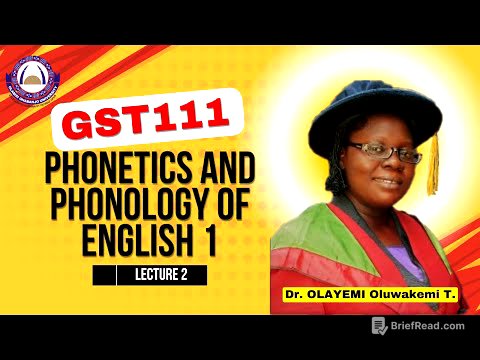TLDR;
This YouTube video by SSC Wallah, led by Pramod Yadav, provides a comprehensive guide to understanding and applying percentages, a fundamental concept in arithmetic math. The session emphasizes the importance of note-taking, observation, and practice for mastering the topic. It covers the definition of percentage, its applications in daily life, methods for converting fractions to percentages and vice versa, and various problem-solving techniques. The lecture includes numerous examples and practice questions to reinforce learning and prepares students for SSC exams.
- Importance of note-taking, observation, and practice for mastering percentages.
- Definition of percentage and its applications in daily life.
- Methods for converting fractions to percentages and vice versa.
- Problem-solving techniques with examples and practice questions.
Introduction [0:20]
Pramod Yadav welcomes viewers to the SSC Wallah online platform, emphasizing the importance of attending the session with a pen and notebook. He highlights that today's session is crucial for both exam preparation and mathematical understanding. The session will cover the topic of percentage, which is considered the soul of arithmetic math.
Understanding Percentage [1:52]
The session begins by defining percentage and discussing its relevance in daily life, such as discounts in shopping malls, calculating marks, bank interests, stock market gains, and salary increments. Percentage is broken down into "per cent," meaning "per 100," indicating a comparison out of 100. The percentage sign (%) is explained as equivalent to 1/100.
Defining Percentage with Examples [6:17]
The concept of percentage is further explained using the example of a student scoring 420 marks out of 600. Instead of stating the raw marks, the score is often converted to a percentage (70%) for easier understanding and comparison. Percentage is defined as a way to represent data with a single number, facilitating comparison and comprehension.
Initial Value and 100% Concept [12:39]
The lecture introduces the concept that anything in the universe is initially complete in itself, representing 100%. Adding to it increases the percentage beyond 100, while reducing it decreases the percentage below 100. This is illustrated with the example of an aloo paratha, initially 100%, and then halved, leaving 50%.
Fractions to Percentages and Vice Versa [17:22]
The session explains how to convert fractions to percentages by multiplying by 100 and percentages to fractions by dividing by 100. Examples include converting 3/4 to 75% and 60% to 3/5. The importance of understanding these conversions for solving percentage-related problems is emphasized.
Extending Percentage Concepts [20:16]
The lecture extends the percentage concept to numbers greater than one, stating that 1 = 100%, 2 = 200%, and so on. Common fraction-to-percentage conversions are listed, such as 1/2 = 50%, 1/3 = 33.33%, and 1/4 = 25%. These conversions are crucial for quick calculations in exams.
Derivatives of Fractions and Their Uses [25:07]
The concept of derivatives of fractions is introduced, where multiples of basic fractions are converted to percentages. For example, if 1/2 = 50%, then 3/2 = 150%. This section also covers how to express fractions greater than one as a sum of 1 and a fraction, such as 4/3 = 1 + 1/3 = 133.33%.
Important Derivatives and Exam-Oriented Fractions [36:47]
Pramod lists important derivatives of fractions frequently asked in examinations, such as 2/7 = 28.56%, 3/8 = 37.5%, and 2/3 = 66.6%. He advises students to focus on these key fractions to save time during exams. The divide and rule strategy is introduced to break down complex percentages into simpler fractions.
Applying BODMAS and Percentage Calculations [43:21]
The session revisits the BODMAS rule, emphasizing that "of" means multiplication. An example problem is presented: 4204% of 25. To solve this, the expression is broken down into simpler percentages (200% + 50% + 1%) and then calculated.
Understanding Initial Value and Percentage Results [54:19]
The lecture explains how to interpret fractions in percentage problems. The denominator represents the initial value, while the numerator represents the percentage result. For example, a 20% profit (1/5) means 5 is the cost price, and 1 is the profit. This concept is illustrated with examples related to profit, loss, and population distribution.
Applying Percentage Concepts to Practical Problems [1:02:06]
The session demonstrates how to apply percentage concepts to practical problems, such as calculating percentage increase or decrease. It emphasizes the importance of understanding the base value on which the percentage change is calculated. Examples include calculating percentage change in numbers and understanding statements involving percentage comparisons.
Ratio Distribution and Percentage Change [1:06:31]
The lecture covers ratio distribution, explaining how to divide a quantity between two entities based on a given ratio. It also explains percentage change, emphasizing that it is always calculated on the initial value. Examples include calculating percentage change in numbers and understanding statements involving percentage comparisons.
Problem Solving with Percentages [1:11:12]
The session transitions to solving various percentage-based problems. These include finding the difference between percentages of numbers, calculating percentages with decimals, and solving word problems involving percentage increase and decrease.
Applying Percentage Concepts to Real-World Scenarios [1:25:33]
The lecture continues with more complex problems, such as those involving errors in multiplication, changes in consumption due to price changes, and calculating percentage changes in geometric figures. The importance of understanding the underlying concepts and applying them logically is emphasized.
Advanced Percentage Problems and Techniques [1:38:50]
The session tackles advanced percentage problems, including those involving multiple variables and complex relationships. Techniques such as component and dividend are used to simplify calculations. The importance of careful reading and understanding the problem statement is highlighted.
Constant Product Rule and Its Applications [1:46:39]
The constant product rule is explained, stating that if the product of two quantities is constant, an increase in one leads to a decrease in the other. This rule is applied to various scenarios, such as distance, speed, and time, as well as revenue, ticket prices, and the area of a rectangle.
Applying Constant Product Rule to Practical Problems [1:50:51]
The constant product rule is applied to practical problems, such as calculating the percentage decrease in consumption due to a price increase. The importance of understanding the relationship between price and consumption when expenditure remains constant is emphasized.
Applying Fraction and Percentage Concepts to Triangles and Cylinders [1:56:12]
The session applies fraction and percentage concepts to geometric problems involving triangles and cylinders. The constant area of a triangle and the constant volume of a cylinder are used to illustrate the inverse relationship between their dimensions.
Applying Percentage Concepts to Mixtures [2:07:00]
The lecture transitions to problems involving mixtures, such as calculating the initial and final prices of sugar after a price reduction and changes in consumption. The importance of understanding the relationships between quantities and applying the concepts of percentage change is emphasized.
Applying Percentage Concepts to Elections [2:14:34]
The session applies percentage concepts to election-related problems, such as calculating the number of votes received by candidates and determining the winner based on percentage margins. The importance of understanding the relationships between total votes, valid votes, and invalid votes is emphasized.
Applying Percentage Concepts to Venn Diagrams [2:18:38]
The lecture introduces the use of Venn diagrams to solve percentage problems involving overlapping sets. The concepts are applied to scenarios such as students passing in different subjects and families owning different types of animals.
Applying Percentage Concepts to Income and Expenditure [2:27:13]
The session applies percentage concepts to problems involving income, expenditure, and savings. The importance of understanding the relationships between these quantities and applying the concepts of percentage change is emphasized.
Commission-Based Problems [3:46:14]
The session tackles commission-based problems, where a salesman earns a percentage of their sales. The lecture provides a step-by-step approach to solving these problems, including calculating the commission earned and the amount deposited in the company.
Concluding Remarks and Homework [3:57:08]
Pramod concludes the session by emphasizing the importance of revisiting the lecture, making notes, and practicing the concepts. He encourages students to solve the homework problems and seek help in the comment section if needed. He reiterates his commitment to covering all topics relevant to the exam and wishes the students success in their preparations.









